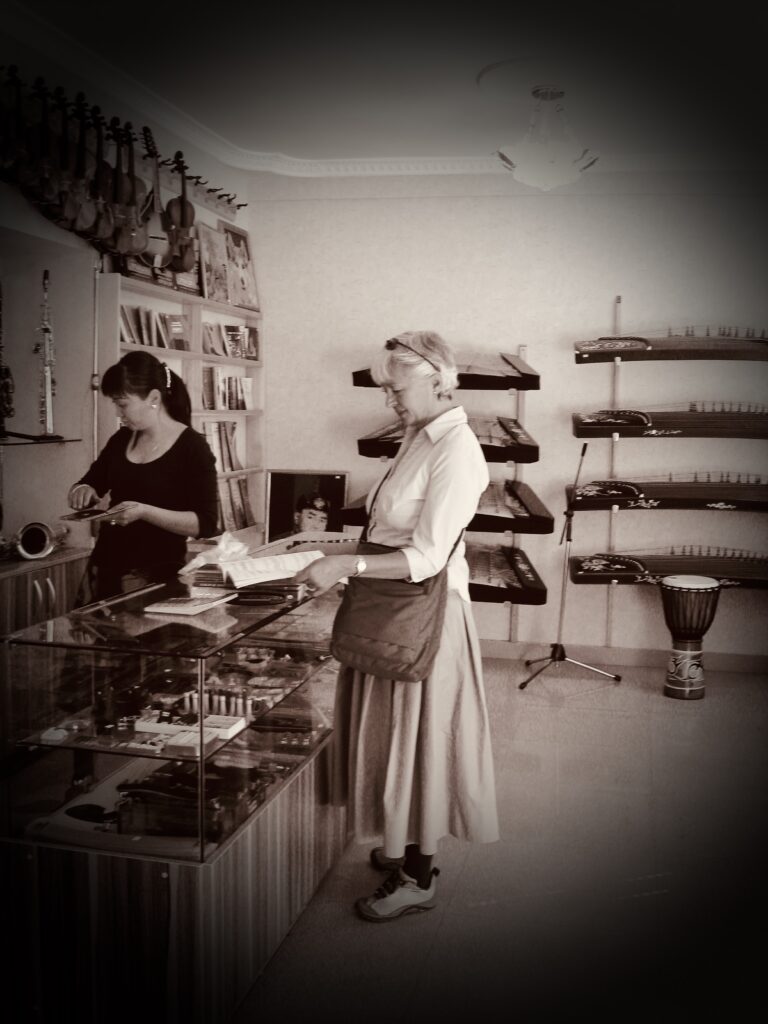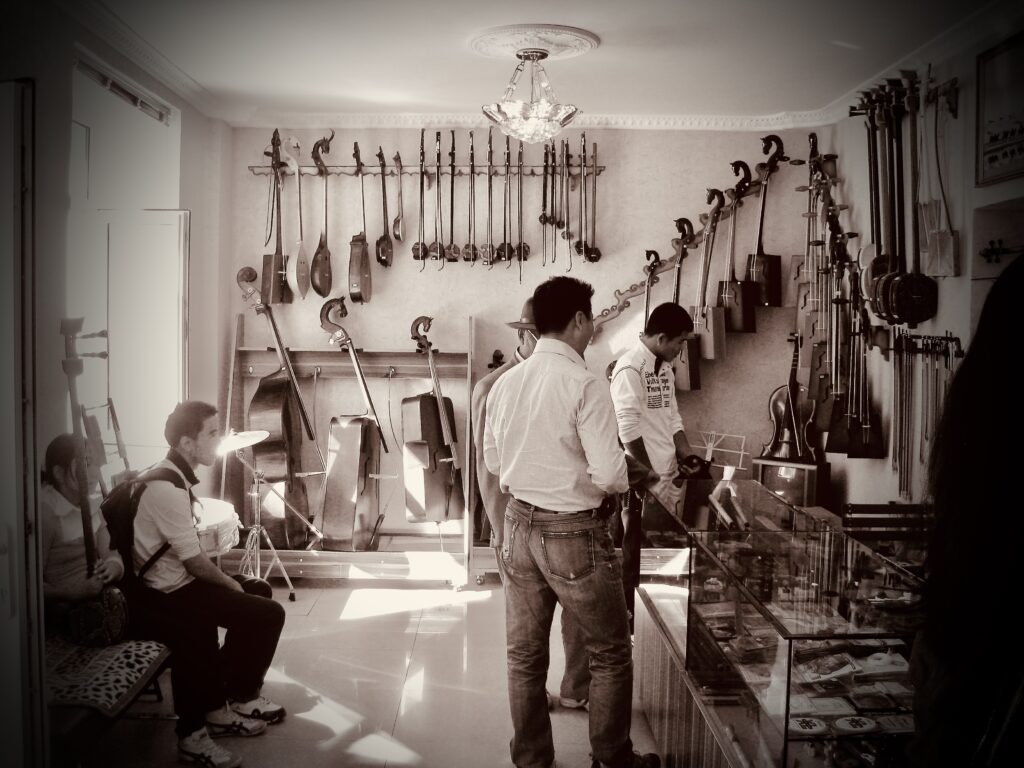This is the backstory to the Nain-Navaa visualised piano improvisation on You Tube. As I work on a musical composition, other considerations spring to mind. Here, for those of you who may be interested, I touch on a few of the more important themes. If you’re just interested in the music video, scroll to the end of this page. There you will find the link to my channel on YT.

One of the first things I like to do after arriving in Ulaanbaatar is to seek out Mongolian music schools and their instrument and sheetmusic rich shop fronts. This one, located near The Government Palace also known as the State Palace on the north side of Sükhbaatar Square in Ulaanbaatar, the capital city of Mongolia, was my favourite. 8 September 2009. Photo courtesy of D. Gerlee.
I have only a few regrets. Not learning to play the morin khuur is one of them. “What is particular about accomplished performers on morin khuur, is that they seem to have mastered the styles of western-oriented classical music, while at the same time appearing and sounding distinctly Mongolian. Such is the mix of “tradition” and “modernity” or the “national” or “international” that one finds upon experiencing Mongolia’s contemporary national music … and it is this unique conception of modern culture .. that makes contemporary Mongolian music so fascinating.”
Source: Edited extract from Peter K. Marsh’s wonderful book (2009) The Horse-head Fiddle and the Cosmopolitan Reimagination of Tradition in Mongolia (Routledge, New York).

Seated, waiting for a lesson in the instrument and sheet music rich entry-reception area of a tuition centre near The Government Palace on the north side of Sükhbaatar Square in Ulaanbaatar, the capital city of Mongolia. 8 September 2009. Photo: C.Pleteshner
This year I have drawn more on my own previous classical training and its euro-centric musical traditions. I am extending these current abilities by studying the art of piano improvisation with Mr Ron Drotos in New York.
My attention has been focused on the works of Mongolian musicians, especially those who have chosen for various reasons to continue to draw from their own learn-ed and deep well of traditional melodies and musicianship lineages. It is in honourable reference to these people, that my own sound, echoing Mongolian cultural valencies, is slowly unfolding using digital keyboards in a digital ecology with MIDI, VSTs and DAWs.
There is gratitude under the name of mother, eternal blue sky
There is gratitude under the beautiful combination of gobi and khang
(ZDR, 5 September 2023)
_____________
From an information management perspective, indexing this backstory to Nain-Navaa on You Tube here on this website, due to its composite ‘nature’, has required the addition of one more category in the information branching design second-level INDEX.
The current set of relevant categorical labels I’ve been using — Soundscape, Artscape, Landscape, Video and Film — have been more than adequate since I started this ethnographic blog nearly 10 years ago. My first post was back in January 2014. However, now neither one nor all, seem adequate as I continue to incorporate additional technologies into the creative performance field. Whilst some of my previous compositions on YT reflect the use of integrated multi-media, this most recent Inter-media work sets new ground. As to why? Here are just a few ideas, some intellectual scaffolding if you like, to shed light on this question.
Inter-Cultural Production
If one looks and listens to works such as the one under consideration here for purely entertainment purposes, then what I am about to say is probably of little or no interest. In inter-cultural literatures, such a perspective can be referred to as cultural consumption. No value judgement implied.
However, from an [inter] cultural production perspective, the viewpoints of those [re]creating the works, there is no shortage of considerations to be addressed. Just the technical stream of development to ‘realise’ the end ‘product’ requires the design and implementation of digital workflows, the selection of digital formats and serious consideration of their inter-operability or not. Hardware, software, specific connectors and fixture, and of course, miles and miles (or kms) of the right kind of black spaghetti. Did you know, that cabling is still required due to latency issues with BT? And so it goes ..
Inter-media is an art theory term first used in the mid-1960s by Dick Higgins, a Fluxus artist. I feel a strong affinity with the Fluxus approach to artistic (in the broadest sense of the word) production. See Soundscape 05: Fluxus in F on this website if you are interested in a more detailed description of Fluxus or to see one of my own Fluxus-inspired compositions.
Intermedia also refers to the strategies of inter-disciplinarity that occur within works existing between artistic genres. See Higgins, D. Intermedia republished in Leonardo Vol. 34, 2001 pp49-54). Also, the term inter-mediacy can be used interchangeably with multi-media, digital media, technoetics and electronic media. Usage depends not only on context, but also the academic subject domain within which a discourse is being performed.
Expanded Cinema (1970) by the American Media Arts theorist Gene Youngblood (1942-2021) was the first book to seriously consider video as an art form. In the book he argues that a new, expanded cinema is required for a new consciousness … It’s not the history of technology. It’s the history of human desire, this desire for connection.
Visual Music
This Nain-Navaa video on You Tube is also a visual performance. Visual music refers to the creation of a visual analogue to musical form by adapting musical structures for visual composition. An expanded definition may include the translation of music to painting. This was the original definition of the term, as coined by Roger Fry in 1912 to describe the work of Wassily Kandinsky. In Ossian Ward’s The Man Who Heard His Paintbox Hiss (9 June 2006).
Visual music also refers to systems that convert music or sound directly into visual forms, such as video, computer graphics, installations or performances by means of a mechanical instrument, an artist’s interpretation or a computer. Visual music has also been defined as a form of intermedia – there it is again! That’s what we have here.
Workflow & Intermedial Production
In the case of this Nain-Navaa video on You Tube, to start with, I developed a leadsheet from listening to the original traditional recording, and then rendered it in a music notation software program (no1). I then performed and recorded a ‘live’ improvisation on a digital piano. Working with the original Nain-Navaa melody line, what you will be listening to is the sustained yet unremediated flow of musical sensibility and consciousness recorded for the final cut. Nothing too grand!
The resulting digital recording was then poured into and then out of various VSTs (Virtual Software Tools). The data stream was fed into a piano VST (no2) via MIDI then out of there and into the DAW (no3) for audio, then out of there and into the computer graphics modelling software (no4) for visual development and rendering, then exported out of there as a .mov to then be transferred and incorporated into another .mov production tool (no5) which renders and exports the final video.mov file which is then uploaded and processed through YT’s easy-peasy drop-and-upload GUI ‘up’ to my YT channel on the YT’s (American) globalised online video sharing and social media platform.
That’s for the music video. And now if we were to continue this digital intermedial workflow production story, having uploaded the music video (as per above), then written the description and established the http//: connections to other digital media from the YT Channel, the next step is to link back to this website and this page that you are reading now.
On this page, and throughout the many pages of this site, you will see scholarly references that inform my work. Some are digital, others are not. However, each one has been entered into bibliographic software and search terms/keywords added, making resources on which I draw easy to search for, easy to retrieve and take only a moment or two to insert and write. Voila! They are inserted preformatted (into yet another application) in whichever bibliographic style I select. The actual authoring of this page (that you are reading now) and insertion of images etc. is carried out in yet another software tool with its own set of limitations and authoring pathways.
Producing, hosting and maintaining a website such as this also requires different licenses, subscriptions, hosting services and again a different range of digital authoring tools. Maybe, in my next life I’ll settle for piccolo!
In terms of a grounded theory of production, this is why I decided that the additional category for my website index needs to be I-N-T-E-R-M-E-D-I-A.
Coloured Hearing
This Nain-Navaa video on You Tube’s sound is “seen” in colour. This is sometimes referred to as coloured hearing. This can involve links between a wide range of perceptions and senses. This is not my area of expertise, so I’ll stop here.
Back to the source: traditional music and it’s provenance
The original Nain Navaa (2008) by Badmaa Khan Ensemble is another beautiful example of traditional music from Buryatia, a mountainous Siberian Republic. Singer Badmaa Khanda leads the vocal ensemble accompanied by traditional instruments: Morin Khuur (horse-headed lute), Yatag (half tube zither), Khun Khuur (swan’s head plucked lute), Limbe (transverse flute), Bish Khuur (reed ‘trumpet’), dulcimer and frame drum.
🎧 Original (2008): https://open.spotify.com/track/40sL8GfvViOSlTTONhbXNw?si=97b2988cb3ea453a
CP’s cover version
CP in Mongolia on You Tube
Attribution
In keeping with ethical scholarly research and publishing practices and the Creative Commons Attribution 4.0 International License, I anticipate that anyone using or translating into another language all or part of this article and submitting it for accreditation or other purpose under their own name, to acknowledge this URL and its author as the source. Not to do so, is contrary to the ethical principles of the Creative Commons license as it applies to the public domain.
end of transcript.
Please refer to the INDEX for other articles that may be of interest.
© 2013-2024. CP in Mongolia. This post is licensed under the Creative Commons Attribution 4.0 International License. Documents linked from this page may be subject to other restrictions. Posted: 4 September 2023. Last updated: 16 October 2023.
